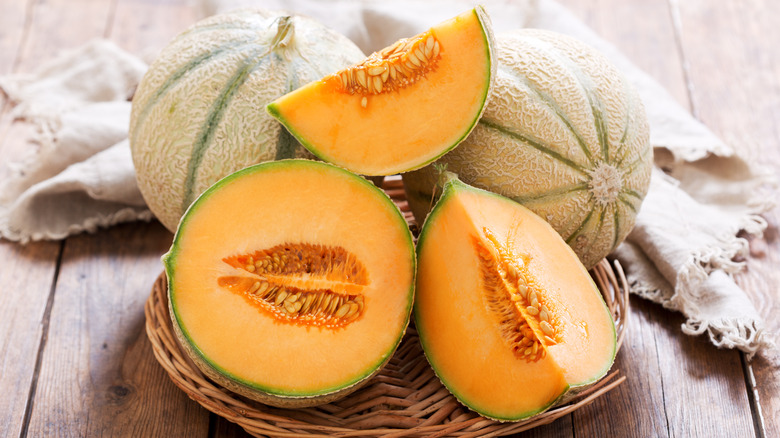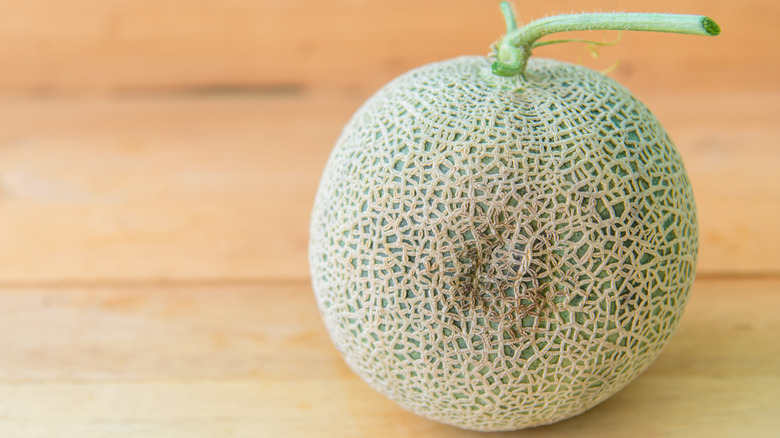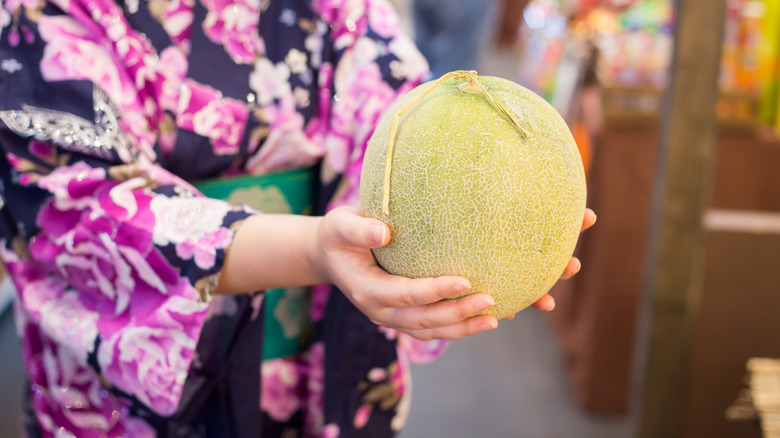How To Tell If Your Cantaloupe Has Gone Bad
Finding a perfectly ripe cantaloupe while shopping in a store is easier said than done. And chances are, once you bring your melon home, you will place it on your counter to further ripen. But, many of us have made the mistake of letting the fruit sit too long until it is no longer good. According to Real Simple, a whole unripe cantaloupe can sit unrefrigerated for up to two days. That is, if you opt not to place it in a closed paper bag to speed up the process. And, an uncut melon can sit in the fridge for up to five days before it starts to go bad. With that said, the length of its viability depends upon when the fruit was picked and shipped to your store, and at what stage you purchased it.
But, what if you have cut it too soon and it's not ripe enough? All is not lost! The Washington Post recommends pureeing it and freezing it. Or use it in a smoothie. PureWow also recommends using pieces for a chutney or salsa, and they suggest putting it on the grill, which will enhance its sweet notes.
Yet when it comes to knowing whether or not your cantaloupe has gone bad, here are the tell-tale signs.
Check the cantaloupe's smell
Smelling a cantaloupe (also known as a muskmelon or a rockmelon) is one of the recommended ways to tell if it is ripe or has gone bad. A perfectly ripe melon will have a sweet, kind of musky aroma that you can gather emanating through the rind. If you don't smell anything, or barely can, it's probably not at its peak (via Leaf). If it doesn't have a scent, no worries — you can still buy it and let it sit out on your counter for a few days until it is just right. Keep in mind that the best spot to smell the cantaloupe is the end opposite of the stem.
The sniff test will also tell if your cantaloupe has gone bad. If there's an unpleasant odor, or maybe a fermented smell, it's likely no longer good (via PureWow). While a rotten cantaloupe may not give a smell off before you cut it, it will certainly release a pungent smell once you do plunge into it. And remember to wash your melon by scrubbing the rind under a stream of water before you slice it. Prevention recommends wiping with a paper towel afterwards as any leftover moisture can protect water and encourage bacteria to grow.
Look at the inside and outside of the cantaloupe
Another way to tell if your cantaloupe is rotten is by looking at the inside and outside of it. Let's start with the outside appearance: So Yummy advises that if you see bruising or discoloration, or see any liquid coming through the rind, then the melon is no longer good. If there's some mold, you can still salvage it. Just cut off the affected piece as well as a couple inches near it, and it can still be enjoyed (via Eat By Date). Though, make sure to wash the kitchen knife you used to cut the mold out before using it to slice up the rest of the fruit. And if you do happen to accidentally eat a moldy piece, fear not. Huff Post reassures that while some people's digestive systems are more sensitive than others, chances are that nothing will happen to you.
As for the inside of the fruit, when the flesh appears to look dark orange or brown, it's probably past its prime. If there's mold on the inside, it should also be tossed. This growth will appear fuzzy in texture and either white or dark in color (via The Whole Portion).
Feel the cantaloupe
Another effective way to tell if your cantaloupe is still viable is by touching it. A good cantaloupe will be totally firm but not so hard it could break a window (via Delishably). Gently press the end opposite of the stem, and if it has only a bit of give, but not too much, it's still good. If the inside or outside of a cantaloupe feels mushy, overly soft, or falls apart in your hands, then it's bad. If you find that your melon is only slightly softer than usual and perfectly fine otherwise, feel free to eat it
You can also test it by tapping it and listening to the sound. It should come off solid and on the low end. If it has a high pitch, that's not ideal. This probably means it has lost its water content and isn't good to eat anymore (via The Whole Portion).
Still not sure you want to toss an overly soft cantaloupe? Commenters on Food52 recommend making cantaloupe sorbet out of it, or whipping together gazpacho, or adding bits to some line and sugar to make granita.



